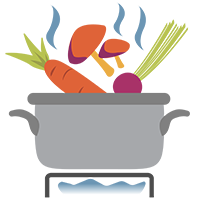
- Why did the yeast apply for a job? It wanted to make some dough!
- What did the bread say to its rival? “You’re toast!”
Did you know there’s a tiny living organism in your pantry? Yeast, which looks a lot like grains of sand, is actually a fungus that’s related to mushrooms and mold. When it “eats” sugar, it produces carbon dioxide, creating tiny bubbles in the process. Yeast is the star of countless kitchen experiments because it makes abstract concepts like fermentation tangible, exciting, and easy to understand. Ready to see it in action? Here are two simple yeast experiments to try with kids at home:
Note: For these experiments, we’ll be using active dry yeast—a pantry staple that’s easy to find and perfect for science activities. Avoid using instant or fresh yeast, as they activate differently and might affect the results.
Experiment 1: The Balloon Blow-Up
Objective: Explore how yeast produces gas during fermentation.
Materials: Plastic bottle, warm water, sugar, yeast, and a balloon.
Steps:
1. Mix warm water, sugar, and yeast in the bottle.
2. Stretch a balloon over the bottle’s neck.
3. Wait and watch as the balloon inflates, thanks to carbon dioxide gas.
Questions to Ask:
- What will happen if we add more sugar?
- How do you think cold water will change what happens?
Why it works: When yeast consumes sugar, it releases carbon dioxide gas, which inflates the balloon.
Experiment 2: The Rising Dough
Objective: Explore how yeast helps bread rise.
Materials: Flour, water, yeast, sugar, a clear container, and a marker.
Steps:
1. Mix a simple dough and place it in a clear container.
2. Mark its starting height.
3. Observe as the dough rises over time.
Questions to Ask:
- Why do you think the dough is getting bigger?
- What do you think happens to the bubbles when we bake the dough?
Why it works: Carbon dioxide from fermentation gets trapped in the dough, making it expand. Experiment with warm vs. cold water to see how temperature affects the process.
Tips for Success
- Let kids mix, measure, and predict outcomes for hands-on learning.
- Remind them not to taste raw experiments but reassure them yeast is safe to handle.
- Embrace the mess—it’s part of the fun!
From Science to Supper!
Ready to turn your science experiments into tasty creations? Sticky Fingers Cooking® offers plenty of kid-friendly recipes that showcase the magic of yeast in action. Try these favorites with your little chefs:
Follow us on Social Media!
Subscribe to the Sticky Fingers Cooking mailing list
Subscribe to our newsletter, The Turnip, to receive exclusive discounts and updates, insider tips + tricks from our awesome team, and instant access to the Sticky Fingers Cooking Starter Kit for free!


